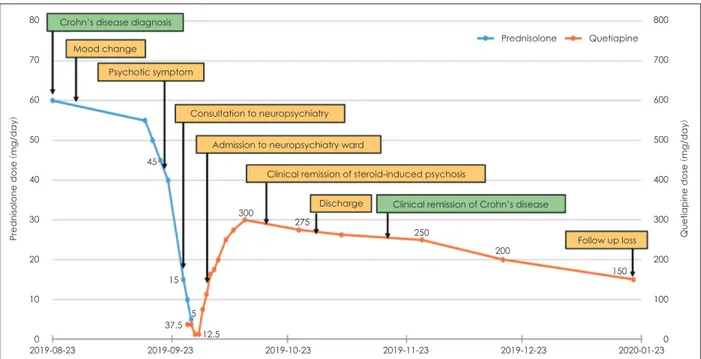Copyright ⓒ 2020 Korean Academy of Child and Adolescent Psychiatry 161
INTRODUCTION
Crohn’s disease is a chronic inflammatory disease that in- volves the upper and lower gastrointestinal tracts, including the oral cavity. Along with ulcerative colitis, it is classified as a subtype of inflammatory bowel disease (IBD). While the etiology of Crohn’s disease has not been clearly identified, it is generally known to result from the combined effects of ge- netic disposition, intestinal microbiota imbalance, inappro- priate immune response, and various environmental factors.
The incidence of IBD among children and adolescents is re- portedly 10 per 100,000 in the United States and Canada, and steroids are commonly used as an effective treatment for in- ducing clinical remission, with mucosal healing achieved in approximately 1/3 of the pediatric patients [1]. However, long- term steroid use causes various adverse effects, including growth retardation in pediatric patients [2] and neuropsy- chiatric complications, such as depression, agitation, mood lability, anxiety, delusion, and psychosis. Among such com- plications, a rare case of steroid-induced psychosis has been reported [3], but no such case has been reported for pediatric patients with IBD in South Korea. We experienced a case of
steroid-induced psychosis that occurred in a pediatric patient with Crohn’s disease after administration of prednisolone as induction therapy. Herein, we report the case together with a literature review.
CASE REPORT
A 16-year-old female visited our pediatric department be- cause of repeated episodes of diarrhea over 3 months. She was admitted for evaluation of chronic diarrhea. She had a height of 154.3 cm and weight of 44.6 kg, both of which correspond- ed to the 10–25 percentile on the growth chart. Laboratory tests performed at admission showed a slightly reduced he- moglobin level (11.2 g/dL), elevated C-reactive protein level (2.58 mg/dL) and erythrocyte sedimentation rate (78 mm/
h), and normal albumin (4 g/dL) and total protein (7.7 g/dL) levels. The calprotectin level in her stool sample was elevated at 3,094 mg/kg. Additional diagnostic immunoassay showed positive findings for the anti-saccharomyces cerevisiae anti- body IgG at 52.2 units. Colonoscopy findings identified mul- tiple superficial ulcers in the terminal ileum, while esopha- gogastroduodenoscopy and capsule endoscopy findings identified aphthous ulcers in the small intestine, including the duodenum. Based on these findings, she was diagnosed with Crohn’s disease with A1b, L1/4a, B1p in the Paris Classi-
This is an Open Access article distributed under the terms of the Creative Commons Attribution Non-Commercial License (https://creativecommons.org/licenses/by-nc/4.0) which permits unrestricted non-commercial use, distribution, and reproduction in any medium, provided the original work is properly cited.
Steroid-induced Psychosis in Adolescent Patient with Crohn’s Disease
Jin Woo Kim 1 , Ki Soo Kang 2 , and Na Ri Kang 3
1
Medical Course, Jeju National University School of Medicine, Jeju, Korea
2
Department of Pediatrics, Jeju National University School of Medicine, Jeju, Korea
3
